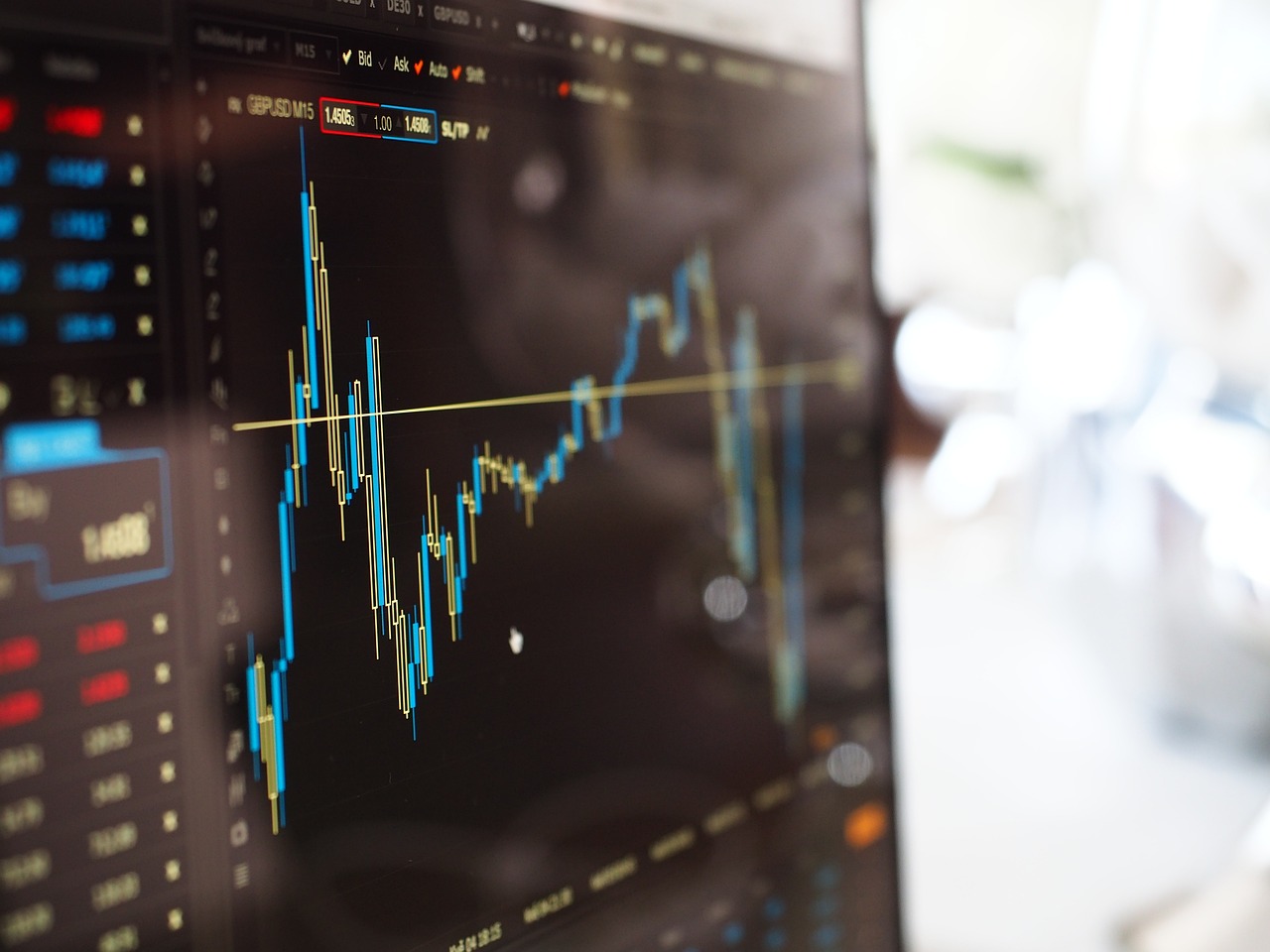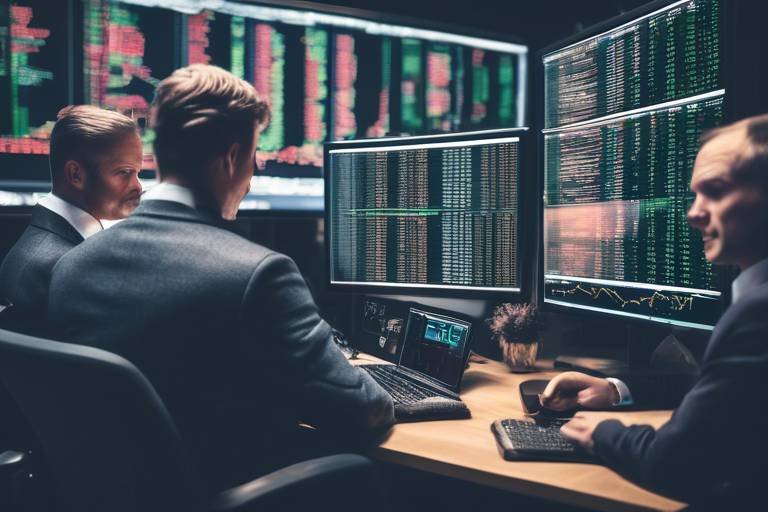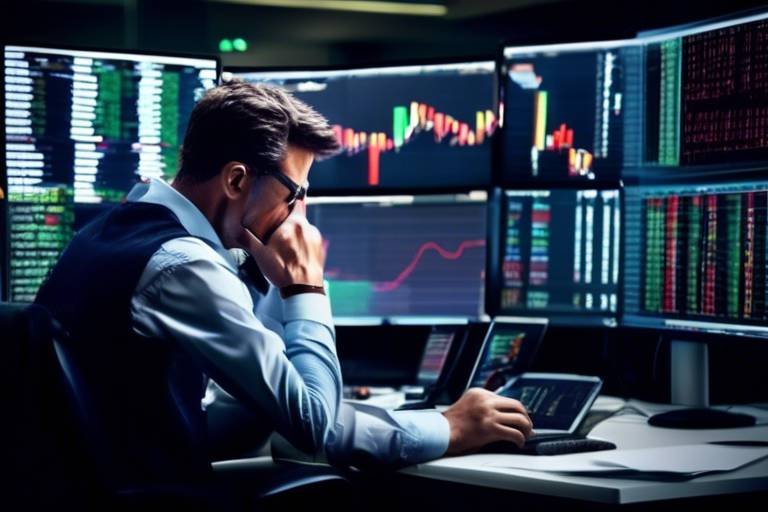How to Utilize Backtesting for Trading Strategies
Backtesting is like having a time machine for your trading strategies. Imagine being able to rewind the clock and test your trading ideas against historical market data to see how they would have performed. This powerful technique allows traders to evaluate their strategies by simulating trades based on past price movements. By doing so, they can gain valuable insights into what works and what doesn’t, ultimately refining their approach to trading.
In the world of trading, where decisions can lead to significant financial outcomes, having a solid strategy is crucial. Backtesting serves as a safety net, providing traders with the opportunity to validate their strategies before risking real capital. It's not just about checking the performance; it's about understanding the nuances of the market and how different strategies can react under various conditions. By leveraging historical data, traders can identify patterns, optimize their strategies, and make informed decisions that enhance their trading performance.
But how does one go about backtesting effectively? The process typically involves several steps: defining a trading strategy, gathering historical data, running simulations, and analyzing the results. Each step is critical in ensuring that the backtest is reliable and that the insights gained are actionable. For example, a trader might start with a simple moving average crossover strategy, apply it to historical data, and then analyze the results for profitability and drawdowns.
Moreover, backtesting isn't a one-time event; it's an iterative process. Traders often revisit their strategies, tweaking parameters and testing them against different time frames or market conditions. This ongoing refinement is akin to a chef perfecting a recipe—each adjustment can lead to a more robust and effective strategy. By continuously backtesting and optimizing, traders can adapt to changing market dynamics and improve their chances of success.
In summary, backtesting is an essential tool in a trader's arsenal. It provides a framework for evaluating strategies, understanding risks, and optimizing performance. By utilizing backtesting effectively, traders can navigate the complex world of financial markets with greater confidence and clarity.
- What is backtesting? Backtesting is the process of testing a trading strategy using historical data to evaluate its effectiveness and potential profitability.
- Why is backtesting important? It helps traders validate their strategies, understand potential risks, and refine their approaches before committing real money.
- How do I start backtesting? Begin by defining your trading strategy, gather historical market data, simulate trades, and analyze the results to make informed decisions.
- What are common mistakes in backtesting? Common pitfalls include overfitting strategies to historical data and ignoring changing market conditions.

Understanding Backtesting
Backtesting is a critical process in the trading world that allows traders to evaluate the effectiveness of their strategies by applying them to historical data. Imagine trying to navigate a maze without knowing the way out; backtesting acts as a map, guiding traders through the complex landscape of market fluctuations and trends. By simulating trades based on past performance, traders can gain insights into how their strategies would have performed in different market conditions. This not only helps in assessing the viability of a strategy but also in identifying areas for improvement.
The primary purpose of backtesting is to provide a framework for traders to validate their strategies before risking real capital. It’s like testing a new recipe in the kitchen; you want to ensure that the ingredients blend well together and that the final dish is delicious. In trading, this means ensuring that your strategy is robust enough to withstand the test of time and various market scenarios. Backtesting involves analyzing historical price data, trading signals, and execution rules to simulate trades as if they were made in real-time.
One of the key components of backtesting is the use of quantitative analysis, which involves statistical techniques to evaluate the performance of a trading strategy. Traders often leverage various metrics to assess their strategies, such as return on investment (ROI), maximum drawdown, and Sharpe ratio. These metrics help in understanding not just the profitability of a strategy, but also its risk profile. For example, a strategy might show high returns but also comes with significant risk, which could be a red flag for many traders.
Furthermore, backtesting allows traders to refine their strategies iteratively. By adjusting parameters and testing different scenarios, traders can discover the optimal settings that yield the best results. This process is akin to tuning a musical instrument; a slight adjustment can make a significant difference in performance. However, it’s crucial to approach backtesting with a mindset geared towards continuous improvement rather than seeking a one-size-fits-all solution.
In summary, backtesting is not just a tool but a vital aspect of a trader's toolkit. It empowers traders to make informed decisions, enhances their understanding of market behavior, and ultimately contributes to better trading outcomes. The next sections will delve deeper into the importance of backtesting, its role in risk management, and how to choose the right software for effective backtesting.

Importance of Backtesting
Backtesting is more than just a fancy term thrown around in trading circles; it is a powerful tool that can significantly influence a trader's success. Think of it as a time machine for your trading strategies, allowing you to travel back and see how they would have performed in various market conditions. By applying your strategies to historical data, you can gain invaluable insights that inform your future trading decisions. This process is crucial for several reasons, most notably for enhancing your understanding of your strategy's effectiveness, managing risks, and validating your approach before you put real money on the line.
One of the primary benefits of backtesting is that it helps traders identify the strengths and weaknesses of their strategies. It’s like a rehearsal before the big show; you get to see what works and what doesn’t without the pressure of live trading. By analyzing historical performance, traders can pinpoint successful patterns and tweak their strategies accordingly. This iterative process not only boosts confidence but also enhances decision-making skills, allowing traders to act swiftly and decisively when real opportunities arise.
Moreover, effective risk management is a cornerstone of successful trading, and backtesting plays a pivotal role in this area. By simulating trades over historical data, traders can assess potential risks associated with their strategies. This analysis helps in setting realistic expectations and preparing for adverse market conditions. For instance, backtesting can reveal the maximum drawdown a strategy has experienced, which is crucial information for any trader looking to protect their capital. Understanding these risks allows traders to adjust their strategies proactively, minimizing potential losses.
Within the realm of risk management, backtesting provides a framework for establishing risk parameters. When you backtest, you can determine how much of your capital you are willing to risk on each trade based on historical data. This helps you to develop a disciplined approach to trading, ensuring that you do not let emotions dictate your decisions. For example, if your backtesting reveals that a particular strategy has historically resulted in a 10% drawdown, you may decide to limit your risk to 2% per trade to safeguard your portfolio.
Setting appropriate risk parameters is not just about protecting your capital; it’s also about enhancing your overall trading performance. By analyzing historical data, you can set realistic targets for returns and determine how much risk you are willing to take to achieve those returns. This process can be summarized in the following steps:
- Analyze historical performance to identify drawdowns.
- Determine your risk tolerance level.
- Set risk parameters that align with your trading goals.
Understanding drawdowns is essential for any trader. A drawdown refers to the peak-to-trough decline during a specific period, and backtesting reveals these historical drawdowns, helping traders prepare for potential future losses. By knowing how much your strategy has historically lost during downturns, you can better manage your expectations and avoid panic during real market fluctuations. This preparation is akin to wearing a life jacket before embarking on a boat trip; it’s all about being ready for unexpected waves.
In conclusion, the importance of backtesting cannot be overstated. It equips traders with the knowledge and tools necessary to refine their strategies, manage risks effectively, and ultimately improve their trading performance. By embracing backtesting, traders can navigate the volatile waters of the financial markets with greater confidence and precision.
Q: What is backtesting?
A: Backtesting is the process of testing a trading strategy on historical data to evaluate its effectiveness before applying it in live markets.
Q: Why is backtesting important?
A: Backtesting helps traders understand the strengths and weaknesses of their strategies, manage risks, and validate their approaches before risking real capital.
Q: How can backtesting improve risk management?
A: By revealing potential drawdowns and historical performance, backtesting allows traders to set realistic risk parameters and prepare for adverse market conditions.
Q: What are common pitfalls in backtesting?
A: Common pitfalls include overfitting strategies to historical data and ignoring changing market conditions, which can lead to misleading results.

Risk Management
Effective risk management is the backbone of successful trading. Without it, even the most promising strategies can crumble under pressure. Think of risk management as your trading safety net; it protects you from the inevitable ups and downs of the market. By utilizing backtesting, traders can identify potential risks associated with their strategies before they put real money on the line. This process not only highlights weaknesses in a trading plan but also allows traders to make informed adjustments that can significantly reduce the likelihood of losses.
When you backtest your strategy, you’re essentially running a simulation of how it would have performed in the past. This historical insight is invaluable. For instance, if your strategy shows a tendency to incur heavy losses during certain market conditions, you can tweak your approach to mitigate those risks. This could involve adjusting your entry and exit points, modifying your position sizes, or even employing different indicators that better align with your trading goals.
Moreover, backtesting helps traders establish a clear understanding of their risk tolerance. By analyzing historical data, you can determine the maximum drawdown you’re willing to accept. This is crucial because it prepares you psychologically and financially for the realities of trading. After all, knowing your limits can keep you from making impulsive decisions during times of market stress.
To illustrate this concept further, consider a scenario where a trader backtests a strategy that shows a maximum drawdown of 30%. This information is a red flag; it indicates that there were periods in the past where the trader would have lost 30% of their capital. Understanding this allows the trader to set risk parameters that align with their comfort level. For example, they might decide to only risk 10% of their capital on any single trade, thereby ensuring they don’t fall into a detrimental financial spiral.
Additionally, backtesting can reveal the frequency and magnitude of drawdowns. Understanding how often and how deep these drawdowns are can help traders prepare for future losses. It’s like having a weather forecast before going on a road trip; you wouldn’t want to be caught off guard by a storm. By recognizing patterns in past performance, traders can develop strategies to weather those storms, ensuring they remain in the game even during tough times.
In summary, risk management is not just about avoiding losses; it’s about creating a sustainable trading plan that can withstand the test of time. By leveraging backtesting, traders can refine their strategies, set appropriate risk parameters, and identify potential drawdowns, all of which contribute to a more robust trading approach. So, the next time you’re developing a strategy, remember that understanding and managing risk is just as important as finding the next big opportunity.
- What is backtesting? Backtesting is the process of testing a trading strategy using historical data to see how it would have performed in the past.
- Why is risk management important in trading? Risk management helps traders minimize potential losses and protect their capital, ensuring long-term success in the market.
- How can backtesting improve my trading strategy? Backtesting allows traders to identify weaknesses in their strategies, optimize parameters, and prepare for different market conditions.
- What are common mistakes in backtesting? Common mistakes include overfitting strategies to historical data and ignoring changing market conditions.

Setting Risk Parameters
When it comes to trading, is like putting on a seatbelt before starting a drive—it's a precaution that can save you from potential harm. Risk parameters are the guidelines that dictate how much of your capital you are willing to risk on any single trade. Without these parameters, traders often find themselves navigating in a sea of uncertainty, which can lead to emotional decision-making and, ultimately, significant losses.
Establishing clear risk parameters is essential for maintaining a disciplined approach to trading. The first step is to determine your risk tolerance, which is the amount of loss you can comfortably withstand without losing sleep at night. This can vary greatly from one trader to another, influenced by factors such as experience, trading style, and financial situation. For instance, a day trader might have a higher risk tolerance compared to a long-term investor who prefers to play it safe.
To help illustrate this concept, consider the following table that outlines different risk tolerance levels and corresponding risk parameters:
| Risk Tolerance Level | Maximum Risk per Trade (%) | Example Trade Size ($10,000 Account) |
|---|---|---|
| Low | 1% | $100 |
| Medium | 2% | $200 |
| High | 5% | $500 |
Once you've determined your risk tolerance, the next step is to establish your stop-loss orders. These orders automatically close a trade when it reaches a predetermined loss level, helping to prevent emotional trading decisions. By setting a stop-loss, you are essentially defining your exit strategy before you even enter the trade. This can significantly reduce the stress associated with trading, as you know exactly when to cut your losses.
Another important aspect of setting risk parameters is the concept of position sizing. This refers to how much of your capital you allocate to a single trade based on your risk tolerance and stop-loss level. For example, if you decide to risk 2% of your $10,000 account on a trade with a stop-loss set at $50, your position size would be calculated as follows:
Position Size (Account Size x Risk Percentage) / Stop-Loss Amount Position Size ($10,000 x 0.02) / $50 4 shares
By carefully calculating your position size, you can ensure that you never risk more than you are comfortable with, which is crucial for long-term trading success. Remember, the goal is to protect your capital while still allowing for potential growth.
In summary, setting risk parameters is not just a good practice; it's a necessity for any trader looking to thrive in the markets. By understanding your risk tolerance, establishing stop-loss orders, and calculating position sizes, you’re equipping yourself with the tools needed to make informed trading decisions. So, buckle up, set those parameters, and get ready to navigate the exciting world of trading with confidence!
- What is the ideal risk percentage per trade? The ideal risk percentage can vary, but many traders recommend risking between 1% to 3% of your trading capital on a single trade.
- How do I determine my risk tolerance? Your risk tolerance can be assessed by considering your financial situation, trading experience, and emotional comfort with potential losses.
- Can I adjust my risk parameters over time? Absolutely! As you gain more experience and confidence in your trading strategies, you may choose to adjust your risk parameters accordingly.

Identifying Drawdowns
When it comes to trading, understanding drawdowns is like knowing the weather before heading out for a hike. Just as you wouldn’t venture into the wilderness without checking the forecast, you shouldn’t dive into trading without a firm grasp of what drawdowns can mean for your strategy. A drawdown refers to the decline in the value of an investment from its peak to its lowest point over a specific period. Identifying and analyzing these drawdowns is crucial for traders who wish to prepare for potential future losses.
Imagine you're on a rollercoaster; the exhilarating climbs are followed by heart-stopping drops. In trading, those drops can be represented by drawdowns. They can occur due to various factors, including market volatility, poor strategy execution, or unexpected economic events. By examining historical drawdowns through backtesting, traders can gain insights into the worst-case scenarios their strategies might face. This understanding can help in developing a more resilient trading approach.
To effectively identify drawdowns, traders should focus on several key elements:
- Maximum Drawdown: This represents the largest drop from a peak to a trough in the historical performance of a strategy. Knowing this helps traders understand the worst-case scenario they might encounter.
- Duration of Drawdowns: It's not just about how deep a drawdown goes, but also how long it lasts. A quick recovery might be manageable, but prolonged drawdowns can be psychologically taxing and financially damaging.
- Frequency of Drawdowns: Understanding how often drawdowns occur can help traders set realistic expectations for their strategies. Frequent small drawdowns might be acceptable, while rare but severe drawdowns could be alarming.
By incorporating these aspects into your backtesting process, you can build a more robust trading strategy. For instance, if your backtesting reveals that a particular strategy has a maximum drawdown of 30%, you might want to reconsider whether you have the emotional and financial capacity to handle that level of risk.
Furthermore, it’s essential to simulate various market conditions during your backtesting to see how your strategy performs during different drawdown scenarios. This practice not only prepares you for the worst but also enhances your confidence when trading live. After all, if you know that your strategy can withstand historical drawdowns, you’ll be less likely to panic during real market fluctuations.
In conclusion, identifying drawdowns is not just a technical exercise; it’s a fundamental part of developing a trading strategy that can weather the storms of the financial markets. By understanding and preparing for drawdowns, you can enhance your trading resilience and improve your overall decision-making process.
1. What is a drawdown in trading?
A drawdown is the reduction of one's capital after a series of losing trades, representing the decline from a peak to a trough in the value of an investment.
2. Why is identifying drawdowns important?
Identifying drawdowns helps traders understand potential risks and prepare for worst-case scenarios, which is vital for effective risk management.
3. How can backtesting help in identifying drawdowns?
Backtesting allows traders to apply their strategies to historical data, revealing past drawdowns and helping them assess the robustness of their trading approach.
4. What should traders do if they find a significant drawdown in their strategy?
Traders should analyze the reasons behind the drawdown, consider adjusting their risk parameters, and possibly refine their strategy to mitigate future losses.

Strategy Optimization
When it comes to trading, the phrase "adapt or die" couldn't be more accurate. This is where enters the picture, acting like a fine-tuning tool for your trading approach. Imagine you're a musician tuning your guitar before a big performance; just as a well-tuned instrument can make beautiful music, a well-optimized trading strategy can lead to impressive profits. Backtesting allows traders to experiment with various parameters, helping to refine their strategies based on historical performance.
So, how does this process work? It starts with iterative testing. Traders can adjust parameters such as entry and exit points, stop-loss levels, and position sizes. By running these adjusted strategies against historical data, one can see how these changes would have performed in the past. It’s like a time machine for your trading strategy! However, it’s crucial to remember that past performance is not always indicative of future results. Therefore, while backtesting provides valuable insights, it should be combined with real-time market analysis.
Moreover, optimization isn't just about finding the best parameters; it’s also about understanding the trade-offs. For instance, a strategy that shows high returns might also come with increased risk. This is where backtesting shines, as it helps traders visualize the risk-reward spectrum through various metrics. Here are a few key metrics to consider during optimization:
- Sharpe Ratio: Measures the risk-adjusted return of the strategy.
- Maximum Drawdown: Indicates the largest drop from a peak to a trough in the equity curve.
- Win Rate: The percentage of trades that are profitable.
By analyzing these metrics, traders can make informed decisions on which strategies to pursue and which to discard. It’s like having a compass that guides you through the tumultuous seas of trading. But, beware of the common pitfall of over-optimization—trying to make a strategy fit historical data too perfectly can lead to poor performance in live trading. This phenomenon is known as overfitting, and it can turn your strategy into a mirage that disappears when faced with real market conditions.
In conclusion, strategy optimization through backtesting is not just a mechanical process; it’s an art form that combines data analysis with strategic thinking. The key is to remain flexible and adaptable, always ready to tweak your approach as market conditions evolve. By embracing this iterative process, traders can not only enhance their strategies but also build the confidence needed to navigate the unpredictable waters of trading.
Q1: What is the main purpose of backtesting?
A1: The main purpose of backtesting is to evaluate the effectiveness of a trading strategy by applying it to historical data, allowing traders to refine their strategies based on past performance.
Q2: Can backtesting guarantee future success?
A2: No, while backtesting provides valuable insights, it cannot guarantee future success as market conditions can change.
Q3: What are some common mistakes in strategy optimization?
A3: Common mistakes include overfitting strategies to historical data and ignoring changes in market conditions.

Choosing the Right Backtesting Software
When it comes to backtesting your trading strategies, choosing the right software can make all the difference. With a plethora of options available, it can feel overwhelming to pinpoint which tool will best suit your needs. Think of backtesting software as the engine of your trading vehicle; without a reliable engine, no matter how polished your strategy, you won’t get far. So, how do you select the right one?
First and foremost, consider the features that are essential for your trading style. Different traders have different needs, and the software should cater to those specific requirements. For instance, if you’re a day trader, you might prioritize speed and real-time data, while swing traders may value comprehensive historical data analysis. A good backtesting tool should allow you to test multiple strategies simultaneously and provide detailed reports on performance metrics.
Additionally, user-friendliness is a crucial factor. You don’t want to spend hours figuring out how to navigate the software. Look for platforms that offer an intuitive interface and provide tutorials or customer support. After all, you want to spend your time refining your strategies, not wrestling with complicated software.
Moreover, it’s important to evaluate the data quality that the software provides. Reliable historical data is vital for accurate backtesting. Some tools come with built-in data feeds, while others require you to import data manually. Ensure that the software you choose provides high-quality, clean data to achieve meaningful results.
Here’s a quick rundown of some key features to look for when choosing backtesting software:
- Robust Reporting: Detailed performance metrics and visualizations.
- Customization: Ability to tweak and optimize your strategies easily.
- Integration: Compatibility with other trading platforms and tools.
- Support: Access to customer service and community forums.
Furthermore, consider the cost of the software. While some tools are free, others come with a hefty price tag. It’s essential to weigh the cost against the features offered. Sometimes, investing in a premium tool can save you money in the long run by providing better insights and more accurate backtesting results.
Finally, don’t forget to look at user reviews and testimonials. Hearing from other traders about their experiences can provide valuable insights into the software’s reliability and effectiveness. Try to find reviews that discuss both the positives and negatives to get a balanced view.
In conclusion, the right backtesting software can significantly enhance your trading strategy. By focusing on essential features, user-friendliness, data quality, cost, and user feedback, you can find a tool that not only meets your needs but also helps you become a more effective trader.
1. What is backtesting software?
Backtesting software allows traders to apply their trading strategies to historical data to evaluate their effectiveness before implementing them in real-time trading.
2. Can I use free backtesting software?
Yes, there are several free backtesting tools available, but they may lack some advanced features compared to paid options. It’s essential to evaluate your needs before choosing.
3. How do I know if the backtesting results are reliable?
Ensure that the software uses high-quality historical data and provides detailed performance metrics. Cross-referencing results with other tools can also help validate findings.
4. Is backtesting the same as paper trading?
No, backtesting involves testing strategies against historical data, while paper trading simulates trading in real-time without financial risk.
5. How often should I backtest my strategies?
Regular backtesting is recommended, especially when market conditions change or when you make significant adjustments to your trading strategy.

Key Features to Consider
When diving into the world of backtesting software, it's essential to pinpoint the key features that can significantly enhance your trading strategy evaluation. Think of backtesting software as a toolbox; the right tools can make all the difference in how effectively you can refine and validate your strategies. So, what should you be on the lookout for?
First and foremost, you want software that offers robust data analysis capabilities. This means the ability to process large datasets efficiently and provide you with detailed reports on your trading strategies. Look for tools that can generate comprehensive performance metrics, such as Sharpe ratio, maximum drawdown, and win/loss ratios. These metrics will help you understand how your strategy would have performed in various market conditions.
Another critical feature is the ability to customize parameters. Every trader has a unique approach, and your backtesting software should allow you to tailor your strategy settings. This flexibility enables you to test various scenarios, helping you find the sweet spot for your trading style. Imagine being able to tweak your strategy as easily as adjusting the volume on your favorite playlist!
Moreover, consider the user interface. A clean, intuitive interface can save you a lot of time and frustration. You want to spend your time analyzing data, not trying to navigate a complicated software layout. A good user interface will allow you to focus on what really matters: your trading strategy.
Additionally, the availability of historical data is crucial. Your software should provide access to a wide range of historical market data, including various asset classes and timeframes. The more data you have, the more accurate your backtesting results will be. Think of it as having a treasure map; the more landmarks you have, the easier it is to find the treasure!
Lastly, don’t forget about community support and resources. A strong community around the software can be invaluable. Look for platforms that offer forums, tutorials, and customer support. This can be the difference between struggling alone and having a whole team of experts to help you navigate challenges.
In summary, when choosing backtesting software, keep these features in mind:
- Robust data analysis capabilities
- Customizable parameters
- User-friendly interface
- Access to extensive historical data
- Strong community support and resources
By focusing on these key features, you’ll be better equipped to select the right backtesting tool that not only meets your needs but also enhances your trading strategy's effectiveness.
Q: What is backtesting?
A: Backtesting is a method used to evaluate the effectiveness of a trading strategy by applying it to historical market data.
Q: Why is backtesting important?
A: Backtesting helps traders understand how a strategy would have performed in the past, allowing them to refine their approaches and manage risks effectively.
Q: Can I overfit my trading strategy during backtesting?
A: Yes, overfitting occurs when a strategy is too closely tailored to historical data, making it less effective in real-world trading. It's essential to maintain a balance.
Q: What features should I look for in backtesting software?
A: Key features include robust data analysis capabilities, customizable parameters, a user-friendly interface, access to extensive historical data, and strong community support.

Popular Backtesting Tools
When it comes to backtesting, having the right tools at your disposal can make all the difference. Just like a chef needs the right knives to create a culinary masterpiece, traders need robust backtesting software to refine their strategies. There are several popular backtesting tools that cater to different trading styles and preferences. Here are a few that stand out in the crowded marketplace:
- MetaTrader 4/5: Known for its user-friendly interface, MetaTrader is one of the most popular platforms among forex traders. It offers built-in backtesting capabilities that allow users to test their strategies on historical data quickly. The platform supports automated trading, which means you can optimize your strategies with ease.
- TradingView: This cloud-based platform is not only great for charting but also offers backtesting features through its Pine Script language. Traders can create custom indicators and strategies, and backtest them using historical data, all within a visually appealing interface.
- Amibroker: A robust tool for serious traders, Amibroker offers advanced backtesting features and a powerful scripting language. It allows traders to run complex simulations and analyze their strategies in depth, making it a favorite among quantitative traders.
- QuantConnect: If you're into algorithmic trading, QuantConnect is a fantastic option. This open-source platform supports multiple programming languages and allows users to backtest strategies across various asset classes. Its cloud-based nature means you can access your projects from anywhere.
- TradeStation: Known for its comprehensive trading features, TradeStation also offers powerful backtesting capabilities. It provides traders with a wide array of tools to analyze their strategies and optimize performance based on historical data.
Each of these tools has its unique strengths and caters to different types of traders. Whether you're a beginner or an experienced trader, choosing the right backtesting tool can help you understand your strategies better and improve your decision-making process. But remember, the tool is only as good as the strategy you apply to it. So take your time to explore these options and find the one that fits your trading style best!
Q: What is backtesting?
A: Backtesting is the process of testing a trading strategy using historical data to see how it would have performed in the past.
Q: Why is backtesting important?
A: Backtesting is crucial because it helps traders assess the viability of their strategies, understand potential risks, and refine their approach before trading with real money.
Q: Can I rely solely on backtesting for trading decisions?
A: While backtesting provides valuable insights, it should not be the only factor in your trading decisions. Market conditions can change, and past performance does not guarantee future results.
Q: What should I look for in backtesting software?
A: Look for user-friendly interfaces, robust data handling capabilities, flexibility in strategy development, and comprehensive analytical tools to evaluate performance.

Common Pitfalls in Backtesting
Backtesting can be a powerful tool in a trader's arsenal, but it’s not without its traps. Many traders, especially those new to the game, fall into common pitfalls that can lead to misguided strategies and ultimately, losses. One of the most significant mistakes is overfitting strategies. This occurs when traders tailor their models too closely to historical data, making them less effective in real-time trading. Think of it like trying to fit a square peg into a round hole; while it might seem to work perfectly in theory, it often leads to failure in practice. Overfitting can give a false sense of security, leading traders to believe their strategy is foolproof when, in reality, it’s only optimized for past performance.
Another pitfall is ignoring market conditions. The financial markets are dynamic, constantly influenced by various factors such as economic indicators, political events, and market sentiment. A strategy that worked well during a bull market may not perform the same way in a bear market or sideways market conditions. It’s crucial for traders to consider these changing environments when backtesting their strategies. A robust backtesting process should include scenarios that reflect different market conditions to ensure that the strategy can withstand various challenges.
Additionally, traders often overlook the importance of transaction costs and slippage during backtesting. In reality, every trade incurs costs—whether through commissions, spreads, or market impact. If these factors are not accounted for, the backtest results may appear more favorable than they actually would be in live trading. Therefore, it’s essential to incorporate realistic assumptions about transaction costs into the backtesting process.
Moreover, data snooping is another common issue. This happens when traders test multiple strategies on the same dataset without proper validation. It’s akin to searching for a needle in a haystack; while you might find a few promising strategies, the likelihood of them performing well in the future diminishes significantly. To combat this, traders should utilize out-of-sample testing—validating their strategies on a separate dataset to ensure their robustness.
Lastly, confirmation bias can cloud judgment. Traders may only seek out data that supports their preconceived notions about a strategy, ignoring evidence that contradicts their beliefs. This selective perception can lead to a distorted view of a strategy’s effectiveness. To counteract this bias, it's advisable to approach backtesting with an open mind, considering both successes and failures equally.
In summary, while backtesting is an invaluable tool for traders, it’s essential to navigate its common pitfalls carefully. By being aware of issues like overfitting, market condition changes, transaction costs, data snooping, and confirmation bias, traders can enhance the reliability of their backtesting results and ultimately improve their trading strategies.
Q1: What is backtesting in trading?
A1: Backtesting is the process of testing a trading strategy on historical data to determine its viability and effectiveness before applying it in live markets.
Q2: Why is overfitting a problem in backtesting?
A2: Overfitting occurs when a strategy is too closely tailored to past data, making it less likely to perform well in future conditions. It gives a false sense of security regarding the strategy's effectiveness.
Q3: How can I avoid common pitfalls in backtesting?
A3: To avoid pitfalls, ensure to account for transaction costs, consider various market conditions, avoid data snooping, and remain objective to prevent confirmation bias.
Q4: What tools can I use for backtesting?
A4: There are several backtesting tools available, such as MetaTrader, TradingView, and Amibroker, each offering different features to suit various trading strategies.

Overfitting Strategies
When diving into the world of backtesting, one of the most common pitfalls traders encounter is overfitting. But what exactly does that mean? Imagine you’re trying to fit a tailored suit; if you make it too snug, it might look great in the mirror but be uncomfortable in real life. Similarly, overfitting occurs when a trading strategy is excessively tailored to historical data, capturing not just the underlying trends but also the noise. This can lead to a false sense of security, where traders believe their strategy will perform flawlessly in the future because it worked perfectly in the past.
Overfitting can manifest in various ways. For instance, a trader might develop a strategy that performs exceptionally well on historical data but fails miserably in live trading. This discrepancy arises because the strategy has been fine-tuned to past market conditions, which may not replicate in the future. To illustrate this, consider the following table:
| Scenario | Backtested Performance | Live Trading Performance |
|---|---|---|
| Scenario A | +30% Return | -10% Return |
| Scenario B | +25% Return | +5% Return |
| Scenario C | +40% Return | -15% Return |
This table highlights how strategies can look promising in backtesting but may not hold up under real market conditions. So, how can traders avoid the trap of overfitting? Here are some effective strategies:
- Keep it Simple: Start with a straightforward strategy and gradually add complexity. This allows you to identify which components genuinely contribute to performance.
- Use Out-of-Sample Testing: Always test your strategy on a separate dataset that was not used during the development phase. This helps ensure that your strategy is robust and not just a product of the data it was trained on.
- Implement Walk-Forward Optimization: This technique involves continuously updating and testing your strategy over different time periods, allowing for adjustments based on changing market conditions.
By being aware of the dangers of overfitting and employing these strategies, traders can develop more resilient trading systems. Remember, the goal is to create a strategy that not only performs well on paper but also stands the test of time in the unpredictable world of trading.
Q: What is overfitting in trading?
A: Overfitting occurs when a trading strategy is too closely tailored to historical data, capturing noise rather than the actual trends, which can lead to poor performance in live trading.
Q: How can I avoid overfitting my trading strategy?
A: To avoid overfitting, keep your strategy simple, use out-of-sample testing, and consider implementing walk-forward optimization to adapt to changing market conditions.
Q: Why is overfitting considered a pitfall in backtesting?
A: It creates a false sense of security, leading traders to believe their strategy is reliable based solely on past performance, which may not hold true in future market scenarios.

Ignoring Market Conditions
When it comes to backtesting trading strategies, one of the most critical mistakes traders can make is . Just like a seasoned chef adjusts their recipe based on the season's freshest ingredients, traders must also adapt their strategies to the ever-changing dynamics of the market. Failing to consider these conditions can lead to misguided conclusions about a strategy's performance.
Market conditions can vary widely, influenced by factors such as economic indicators, geopolitical events, and shifts in market sentiment. For instance, a strategy that performs well during a bullish market may completely flop during a bearish phase. This inconsistency is why backtesting should not only focus on historical performance but also take into account the context in which that performance occurred.
To illustrate this point, consider the following table that outlines different market conditions and their potential impact on trading strategies:
| Market Condition | Impact on Trading Strategy |
|---|---|
| Bull Market | Strategies focused on buying and holding may thrive, but short-selling strategies can suffer. |
| Bear Market | Short-selling strategies may perform well, while long positions could lead to losses. |
| Sideways Market | Range-bound strategies may succeed, but trend-following strategies might struggle. |
| High Volatility | Strategies that capitalize on price swings may do well, but risk management becomes crucial. |
Understanding these market conditions is essential for traders who want to refine their strategies effectively. For example, if a trader backtests a strategy that worked well in a bull market but then applies it without adjustment during a bear market, they might be setting themselves up for failure. It’s akin to trying to use a summer wardrobe in the depths of winter; it just doesn’t fit the environment.
Moreover, it’s essential to incorporate a variety of market scenarios into the backtesting process. This can be achieved by:
- Testing strategies across different time frames.
- Using data from various market conditions to simulate real-world scenarios.
- Incorporating economic indicators that may affect market performance.
By doing so, traders can better understand how their strategies might perform under various circumstances, thus enhancing their robustness and reliability. Ultimately, the goal is to create a strategy that not only looks good on paper but also stands the test of time, no matter what the market throws at it.
In conclusion, ignoring market conditions during backtesting is a recipe for disaster. By paying attention to these factors, traders can make informed decisions, refine their strategies, and ultimately improve their chances for success in the unpredictable world of trading.
Q1: Why is it important to consider market conditions in backtesting?
A1: Market conditions can significantly influence the effectiveness of a trading strategy. By considering these factors, traders can better assess the robustness of their strategies in different scenarios.
Q2: How can I incorporate different market conditions into my backtesting?
A2: You can simulate various market conditions by using historical data from different time periods, adjusting your strategy parameters, and testing across multiple time frames.
Q3: What are common market conditions that affect trading strategies?
A3: Common market conditions include bull markets, bear markets, sideways markets, and periods of high volatility. Each of these conditions can impact the performance of trading strategies differently.
Frequently Asked Questions
- What is backtesting in trading?
Backtesting is a process where traders test their trading strategies against historical market data to evaluate their effectiveness. By applying their strategies to past data, traders can see how they would have performed and make necessary adjustments before risking real money.
- Why is backtesting important for traders?
Backtesting is crucial because it provides insights into how a strategy might perform in real market conditions. It helps in identifying strengths and weaknesses of a strategy, allowing traders to refine their approach and make informed decisions, ultimately leading to better risk management.
- How does backtesting aid in risk management?
Backtesting allows traders to identify potential risks by analyzing historical performance. By understanding how a strategy has reacted during different market conditions, traders can set appropriate risk parameters and prepare for possible drawdowns, which is essential for minimizing losses.
- What should I look for in backtesting software?
When choosing backtesting software, key features to consider include user-friendliness, the ability to customize strategies, comprehensive historical data access, and robust analytical tools. These functionalities ensure that traders can perform effective backtesting and gain valuable insights.
- What are some common pitfalls in backtesting?
Common pitfalls include overfitting, where a strategy is too closely tailored to past data, making it less effective in the future. Additionally, ignoring changing market conditions can lead to misleading results. It's crucial to be aware of these issues to ensure the reliability of backtesting outcomes.
- Can backtesting guarantee future success in trading?
While backtesting provides valuable insights, it cannot guarantee future success. Market conditions are constantly changing, and past performance does not always predict future results. Traders should use backtesting as one of many tools in their decision-making process.



















